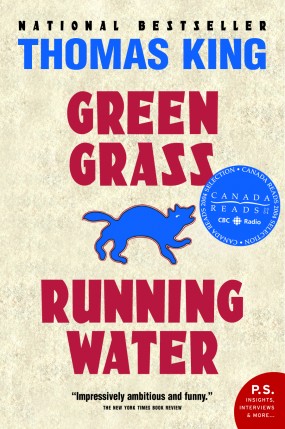
Green Grass, Running Water (1993) by Thomas King. From Green Grass, Running Water © 1993 by Thomas King. Reprinted with permission of HarperCollins Canada.
Borders, subversion, and humour
In Green Grass, Running Water, Thomas King juxtaposes various figures, narratives, communities, and traditions. King explores their strengths and flaws, while subverting and satirizing stereotypes and assumptions about Indigenous peoples and cultures.
In Canadian Literature, prominent literary and cultural critics Margery Fee and Jane Flick describe King’s writing style in Coyote Pedagogy
as a purposeful transition between different historical, cultural, and literary perspectives. Blanca Chester also discusses King’s style in her article Theorizing the World,
focusing on how it employs these switches between perspectives to comment on the nature of stories and communities.
W. H. New, the former editor of Canadian Literature, ruminates in his editorial On the Border
that various social and cultural boundaries are permeable. This permeability helps us break from “conventional paradigms” that assume a sense of fixity and control. Especially given this sense of rigidity, New suggests that it is crucial that we traverse boundaries:
we need to walk close enough to the borders to recognize where they lie, sometimes to cross them if we can, if only to know that they can be crossed, to affirm that … we also know we do not constrict the world we already accept by the way we (and others) draw the frame. (7)
Throughout Green Grass, Running Water, King illustrates the boundaries between cultures, places, histories, stories, communities, and individuals. For instance, Florence Stratton, in her article Cartographic Lessons,
explores how mapping practices connect to colonial power and the control of discourse. Stratton argues that King subverts and re-presents the discriminatory views that pervade representations of Indigenous peoples. Similarly, Marlene Goldman, in her article Mapping and Dreaming,
argues that King enacts Indigenous mapping practices to subvert colonial discourses. According to Goldman, King asserts “an aboriginal conception of the world in which the individuals can locate themselves at the centre of a land-based, communal, and non-hierarchial spiritual practice that involves both body and soul” (20).
These different types of “border-crossings,” re-presentations, and transformations raise questions about the frames and constrictions we place upon the world and our experiences.
- Permeability: How do these border-crossings work and feel—are they subtle or overt, surprising or jarring? Consider, for example, the content tied to moments of permeability and awareness of borders in the novel. How do these moments impact understandings of events, characters, and ways of knowing?
Cultures and mythologies in contact
Green Grass, Running Water features salient connections and juxtapositions between traditions and mythologies. As Florence Stratton argues, King’s major concern in Green Grass, Running Water is with the ways and means of resistance to the mechanisms of colonial power
(91) through border-crossing. King’s rewriting strategies enact this resistance and illustrate that identity is fluid and malleable rather than static. Thus, postcolonial critic Herb Wyile argues in his Canadian Literature article
that King’s novel illustrates the Trust Tonto
creative potential
of a complex and hierarchized set of cultural interactions, negotiations, appropriations and subversions at a textual level that are a reflection of larger dynamics within Canadian society
(122).
- Disruption: Alternative perspectives on stories and events disrupt reader’s engagements with them. For instance, the novel opens with an origin story for the Judeo-Christian God, recasting “Him” as one of Coyote’s dreams that’s become egocentric and egotistical (see Goldman 30). Consider how such defamiliarizing moments function to question particular mythological, literary, and colonial perspectives.
- Layers and integrations: King regularly switches between different stories, layering (and sometimes integrating) multiple narratives together. Why might King have chosen to layer the origin stories of Sky Woman in with literary tales, or integrate the legendary shifting figures of the four old (wo)men with contemporary depictions of daily life?
Characters and Communities
Throughout the novel, characters struggle with the cultural and social expectations of others around them. For instance, Alberta struggles with “want[ing] a baby without a man” (Wyile 115); Eli is the sole person left struggling against the damming of his valley; Lionel struggles with future directions and questions of identity. Each of these characters seems to come to some sort of resolution of their struggle through different interactions with mythological figures and cultural practices. These transformations illustrate the ongoing reassessments and revitalizations of traditions throughout the novel.
- Eroding Eurocentrism: Discuss how the novel slowly erodes the models of identity embodied in religious and literary narratives, particularly through the figures of Sky Woman/Thought Woman and Coyote. How does retelling these Western stories with contrasting characters reinterpret the Western perspective?
- Naming and satire: Consider the use of humour and satire in the novel, especially through characters’ names. King plays with many of the characters’ names to hint at links to historical, literary, and cartoon figures (see Wyile 120–21). How do the names and other moments of satire comment on racialization, culture, and societal stereotypes or assumptions?
Works Cited
- King, Thomas. Green Grass, Running Water. Toronto: HarperCollins, 1993. Print.
- Chester, Blanca [Blanca Schorcht].
Green Grass, Running Water: Theorizing the World of the Novel.
Canadian Literature 161/2 (1999): 44–61. Print. (PDF) - Fee, Margery, and Jane Flick.
Coyote Pedagogy: Knowing Where the Borders Are in Thomas King’s Green Grass, Running Water.
Canadian Literature 161–62 (1999): 131–39. Print. (PDF) - Goldman, Marlene.
Mapping and Dreaming: Native Resistance in Green Grass, Running Water.
Canadian Literature 161–62 (1999): 18–41. Print. (PDF) - New, W. H.
On the Border.
Editorial. Canadian Literature 144 (1995): 4–7. Print. (PDF) - Stratton, Florence.
Cartographic Lessons: Susanna Moodie’s Roughing It in the Bush and Thomas King’s Green Grass, Running Water.
Canadian Literature 161–62 (1999): 82–102. Print. (PDF) - Wyile, Herb.
Canadian Literature 161–62 (1999): 105–24. Print. (PDF)Trust Tonto
: Thomas King’s Subversive Fictions and the Politics of Cultural Literacy.








 ©
©